the place where Paleontology and Paleoanthropology meets Philately
The Marshall Islands
Dinosaurs and other prehistoric animals, Charles Darwin on stamps and postmarks of the Marshall Islands
| << previous country | back to index | next country >> |
Contents:
- Country overview
- Philately of the Marshall Islands
- Official stamps of the Marshall Islands related to Paleontology
- Other stamps of the Marshall Islands to consider
- Commemorative postmarks of the Marshall Islands related to Paleontology
- References
- Acknowledgements
The Marshall Islands, officially the Republic of the Marshall Islands is an island country located near the equator in the Pacific Ocean, slightly west of the International Date Line.
Geographically, the country is part of the larger island group of Micronesia.
The Marshall Islands share maritime boundaries with the Federated States of Micronesia to the west, Wake Island to the north, Kiribati to the south-east, and Nauru to the south.
The country's population is about 60,000, it is spread out over 29 coral atolls, comprising 1,156 individual islands and islets.
The chain of volcanic islands and coral atolls formed at end of the Cretaceous.
As they were and still are isolated from the mainland,
dinosaurs and other terrestrial prehistoric animals weren't present there.
Fossils discovered on the islands are fossils of prehistoric marine animals,
Echinoids (sea urchin) for example.
Spain claimed the islands in 1592, then sold some of the islands to the German Empire in 1885 and they became part of German New Guinea.
In World War I, the Empire of Japan occupied the Marshall Islands.
In 1944, during World War II, the United States took control of the islands in the Gilbert and the Marshall Islands campaign.
Since 1947, the Marshall Islands became part of the United Nations Trust Territory of the Pacific.
Politically, the Marshall Islands is a presidential republic in free association with the United States, with the US providing defence, subsidies, and access to U.S. based agencies such as the FCC and the USPS.
With few natural resources, the islands' wealth is based on a service economy, as well as some fishing and agriculture; aid from the United States represents a large percentage of the islands' gross domestic product. The country uses the United States dollar as its currency. [R1]
The first stamps that used on the Marshall Islands, between 1888 and 1900, were German stamps with "Marschall-Inseln" overprint. Since 1901 Germany produced some stamps of "Marschall-Inseln" with "Deutsche Pfenning" currency.
During Japanese occupation, between 1914 and 1944, Japanese stamps were used on the islands and between 1944 and 1984, USA's stamps.
The first stamps issued by the country by themselves were in 1984. [R2]
In the early years, the Marshall Islands outsourced their stamps production to USA based Inter-Governmental Philatelic Corporation (IGPC). On August 1989, another US based company, Unicover Corporation replaced IGPC. In 2018, IGPC has been appointed the exclusive philatelic agent of the Marshall Islands again.
1984-1997, the country issued 50 stamps a year, on average.
Between 1998 and 2018, the average annual amount of stamps issued on behalf of this small country, was about 200.
Stamps of prehistoric animals, issued during this period, shows dinosaurs and other prehistoric animals discovered in other parts of the world:
USA, Europe, Australia, New Zealand.
Distinguished from other countries who issued too many stamps a year, stamps of the Marshall Islands have a good, unique design.
For example:
- "Dinosaurs" stamps from 2008 designed by Mr. Geoffrey Cox, a leading author and illustrator of New Zealand natural history books, who also designed the Dinosaur stamps of New Zealand in 1993.
- The “Prehistoric Animals” stamps from 2009 are designed after works by the American artist, Don Balke. He is best known for his watercolor wildlife art and scenic oil paintings.
-
"Dinosaur Bones" stamps from 2015, based on illustrations of English artist, Mr. Bryan Kneale,
who painted it in 1991.
It was used on cachets of Fleetwood's FDC for the Great Britain
Owen's Dinosauria 1841 stamps.
(Fleetwood - FDC maker company, established in 1941 in USA. Was a part of Unicover Corporation, before it was acquired by Mystic in 2007).
Official stamps of the Marshall Islands related to Paleontology: dinosaurs and other prehistoric animals, petrified forest, Charles Darwin
| 19.06.2008 "Dinosaurs" | 24.11.2009 "Prehistoric animals" | 23.04.2012 "Great Scientists of the World" |
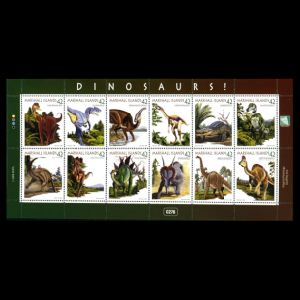 |
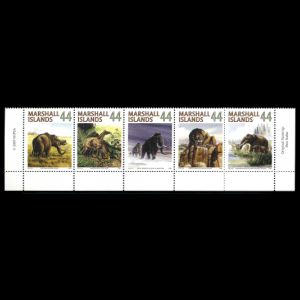 |
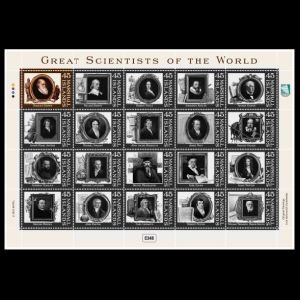 |
| 15.01.2015 "Dinosaur Bones" | 10.05.2017 "National Park" | |
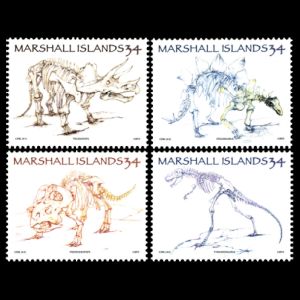 |
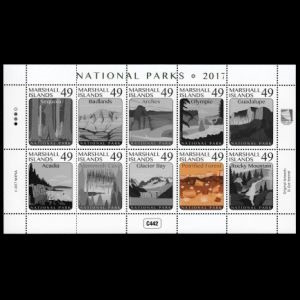 |
 |
Notes:
[1] Charles Darwin and Carl Linnaeus among other great scientists on stamp of the Marshall Islands 2012.
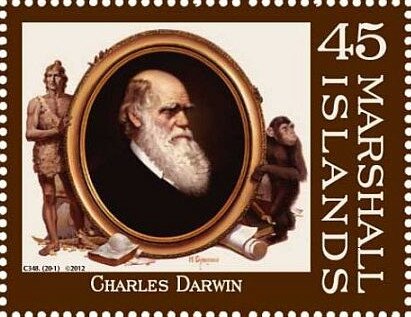
|
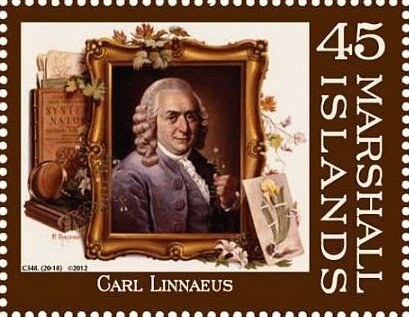
|
|
Charles Darwin on stamp of the Marshall Islands 2012. MiNr.: 2924, Scott: 1032a. |
Carl von Linne on stamp of the Marshall Islands 2012. MiNr.: 2941, Scott: 1032r. |
His proposition that all species of life have descended from a common ancestor, published in his most famous book "On the Origin of Species" in 1859.
This theory is now widely accepted and considered a fundamental concept in all biological science, including paleontology. [R6]
Carl Linnei or Carl Linnaeus (1707 - 1778), was a Swedish botanist, physician, and zoologist, who laid the foundations for the modern scheme of binomial nomenclature used in all biology-related sciences, including paleontology. He is known as the father of modern taxonomy, and is also considered one of the fathers of modern ecology. [R7]
[2] The second issue of "National Park" stamps (1st set issued in 2016), has one Paleontology related stamp.
Petrified Forest National Park is a United States national park in Navajo and Apache counties in northeastern Arizona, USA. Named for its large deposits of petrified wood, the fee area of the park covers about 600 square kilometers, encompassing semi-desert shrub steppe as well as highly eroded and colorful badlands. The Petrified Forest is known for its fossils, especially fallen trees (some are seen on the stamp) that lived during the Late Triassic Period, about 225 million years ago.
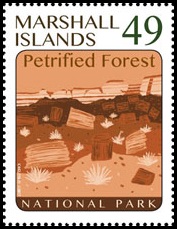
|
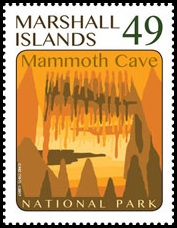
|
|
Petrified wood on stamp of the Marshall Islands 2017. MiNr.: 3841, Scott: |
Mammoth Cave on stamp of the Marshall Islands 2017. MiNr.:, Scott: |
Beginning about 60 million years ago, the Colorado Plateau, of which the park is part, was pushed upward by tectonic forces and exposed to increased erosion.
All of the park's rock layers above the Chinle, except geologically recent ones found in parts of the park, have been removed by wind and water.
In addition to petrified logs, fossils found in the park include Late Triassic ferns, cycads, ginkgoes, and many other plants as well as fauna including giant reptiles called phytosaurs, large amphibians, and early dinosaurs.
Paleontologists have been unearthing and studying the park's fossils since the early 20th century. [R3]
Another stamp shows a landscape from Mammoth cave.
Mammoth Cave National Park is a U.S. national park in central Kentucky, encompassing portions of Mammoth Cave, the longest cave system known in the world.
Since the 1972 unification of Mammoth Cave with the even-longer system under Flint Ridge to the north, the official name of the system has been the Mammoth-Flint Ridge Cave System.
The park was established as a national park on July 1, 1941. It became a World Heritage Site on October 27, 1981
No fossils of the woolly mammoth have ever been found in Mammoth Cave, and the name of the cave has nothing to do with this extinct mammal.
Rather, the name "Mammoth" refers to the large width and length of the passages connecting to the Rotunda just inside the entrance.
This name was given long before the cave system's true extent was fully known. [R4]
Other stamps of the Marshall Islands to consider: fossil found places
| 15.12.2016 "National Parks" [A1] | ||
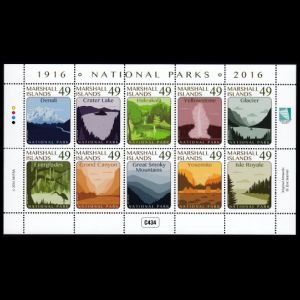 |
|
|
Notes:
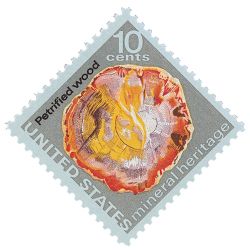
|
| Petrified wood on stamp of USA 1974 MiNr.: 1145, Scott: 1538 |
Yellowstone was the first national park in the U.S. and is also widely held to be the first national park in the world.
Native Americans have lived in the Yellowstone region for at least 11,000 years.
Yellowstone National Park has one of the world's largest petrified forests, trees which were long ago buried by ash and soil and transformed from wood to mineral materials, as shown on USA's stamp from 1974.
This ash and other volcanic debris are believed to have come from the park area itself as the central part of Yellowstone is the massive caldera of a super volcano. [R5]
Commemorative postmarks of the Marshall Islands related to Paleontology: dinosaurs and other prehistoric animals
Legend is here| 19.06.2008 "Dinosaurs" [FDC] | 24.11.2009 "Prehistoric animals" [FDC] | |
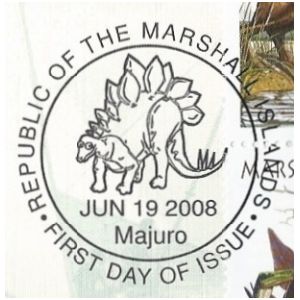 |
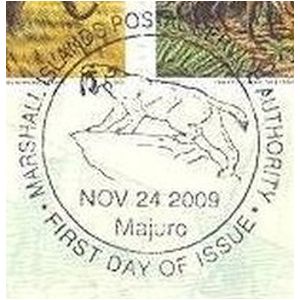 |
|
References:
- [R1] the Marshall Islands:
Wikipedia,
WikiTravel,
FlagCounter
- [R2] Postal History and Philately of the Marshall Islands:
Wikipedia,
German colonies (Wikipedia),
Linns News,
"In quest for abusive and undesirable stamp issues" by Jari Majander, published in Nr. 29 of TCNews (p. 24-64),
Links to official website of the Post Authority, stamp catalog and a list of new stamps of the Marshall Islands are here - [R3] Petrified Forest National Park, USA: Wikipedia.
- [R4] Mammoth Cave National Park, USA: Wikipedia.
- [R5] Yellowstone National Park, USA: Wikipedia.
- [R6] Charles Darwin: Wikipedia.
- [R7] Carl Linnei: Wikipedia.
Acknowledgements:
Many thanks to Dr. Peter Voice from Department of Geological and Environmental Sciences, Western Michigan University, for reviewing the draft page and his valuable comments.
| << previous country | back to index | next country >> |